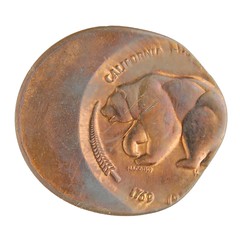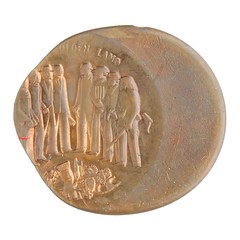
PREV ARTICLE
NEXT ARTICLE
FULL ISSUE
PREV FULL ISSUE
VOCABULARY TERM: OFF CENTER
Dick Johnson submitted this entry from his Encyclopedia of Coin and Medal Terminology. Thanks.
-Editor


This medal, struck in a coining press, did not feed properly into coining position. It is a typical off center strike exhibiting part design, and part the original blank. Most items struck off center are struck in a coining press. Off center items stuck in a medal press would be extremely rare because it is examined at each manual placing into position for each strike. Off Center. A striking error in which a blank does not fully enter into coining position and is struck only partially on its surface. In general off center coins are struck outside the collar, usually distorting the precise circle of the blank, with proper congruent obverse and reverse designs but leaving unstruck a crescent shaped area on the blank. Off center coins are an anomaly of the feeding mechanism. It is the responsibility of this mechanism to pick up a single blank from the feeder tube and deliver this to a position above the collar, where the blank falls by gravity into coining position within the collar. When, for any reason, this does not happen the dies will create these partial strikes. The collar normally forms the edge of the coined piece – either squared plain edge or reeded from the collar – since the blank is struck outside the collar all off center coins will have unshaped edges. The edges will appear either as they came from upsetting (that portion outside the collar), or as rounded flash from the blow outside the collar. Often, off center struck pieces are not ejected. They may receive a second or subsequent blow. Also they may adhere to the die and form capping or cupping. Off center strikes are totally random. They have occurred since striking has been mechanized, being an unfortunate but typical anomaly of presswork. These objects are rejects of coin production and are customarily discarded and melted. Very few early specimens have survived. Many kinds of modern off center coins exist. These include: (1) Off center strike. The blank was not fed properly and did not fully reach coining position inside the collar. Instead it comes to rest partly on top of the collar, receives the blow of both dies on the part of the blank extending over into the collar. The portion not coming between the dies, obviously does not receive an impression and remains blank. The degree off center can range from a very small amount to only the slightest amount struck by the dies. Collectors express this by a percentage of degree, 95% off center would exhibit only the slightest amount of design showing. The position of an off center strike is indicated by the position of a clock face. Off center coins which still retain the date of the piece – as in the 12 o’clock position –have more allure to error collectors. Some collectors form "clock" exhibits of off center strike coins by the 12 clock positions and range from a few degrees off to 95% off. (2) Double and multiple strike. Usually an anomaly of ejection, a coined piece struck a second time off center will be an off center multiple strike. Such an example would show parts of two impressions of die striking. Or a double strike can be a feeding error where the blank was only partially in position for a first blow, and yet struck again for a second blow – or rarely – for a third or subsequent blow. (3) Saddle strike. These occur only when two or more dies (as quads with four dies) are locked side-by-side into position and the press forms as many coins with one blow as the number of dies in position. Two (or four) blanks are fed into coining position for each cycle of the press. When a blank is not fed into coining position between a pair of dies, but instead it comes between two dies – straddling across both and obviously not in either collar – each die will strike a portion of the planchet leaving the unstruck blank portion in the center. This center portion is usually buckled from the outward thrust of the blow, hence the term saddle (as if it were a tiny saddle). There are several sub-varieties of saddle strikes, with and without previous struck pieces in one or both coining positions, for example. Others exist. (4) Chain strike. Essentially a chain strike occurs when two blanks are fed into coining position at one time. The interface edge surfaces of the two pieces form in an unusual manner. They will flatten against each other and somewhat form a straight edge. These edges can be mated or matched with each other because of the design and their congruity. However, obtaining the two matching pieces is extremely rare. The two mated pieces form a dramatic exhibit.
CLASS 06.9
The Numismatic Bibliomania Society is a non-profit organization promoting numismatic literature. See our web site at coinbooks.org. To submit items for publication in The E-Sylum, write to the Editor at this address: whomren@gmail.com To subscribe go to: https://my.binhost.com/lists/listinfo/esylum All Rights Reserved. NBS Home Page Contact the NBS webmaster 
|